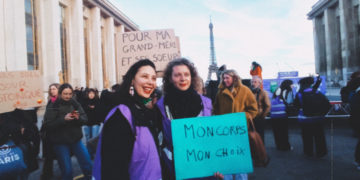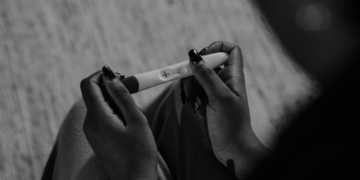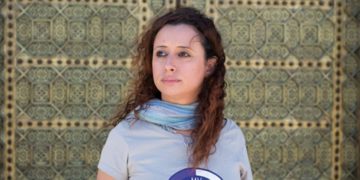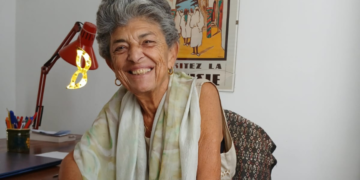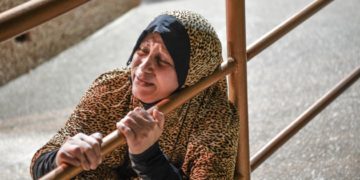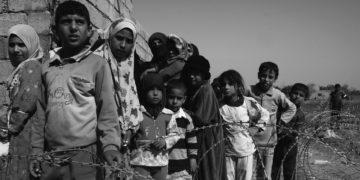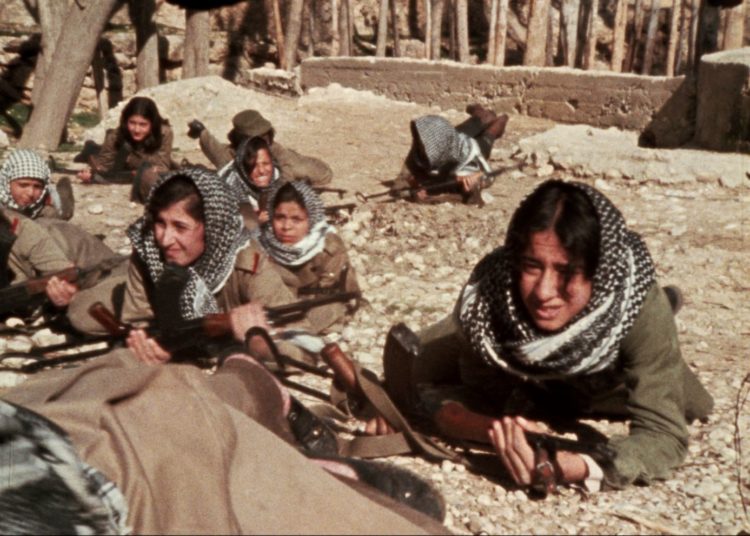This post is also available in: Français (French) العربية (Arabic)
Few Moroccan actresses have spoken publicly about the violence and harassment they face in the arts field, for fear of retaliation or forced exclusion from work. But the actress Najat Khair Allah daringly named the men who harassed her on the Charisma show, which aired two years ago.
Khair Allah said that someone kidnapped her, someone else wanted her to go to his home, and yet another person had a bed in his private office and bargained with actresses for leading roles. She had previously filed a complaint against the actor Tarik Boukhari, accusing him of sexually harassing her several times while filming the series Al-Khawa in 2015.
In a symposium organized by the Moroccan Association for Victims’ Rights in 2021, Khair Allah spoke out about the details of the violence she’d been subjected to at the hands of Boukhari. “I was in the dressing room with the wardrobe coordinator when Tarik suddenly came in and grabbed me. He threw me on the bed and flung himself on top of me. But I know the wardrobe coordinator would never testify against him. She’s also a woman—if she testifies in my favor, she’d never dream of getting another job.”

Khair Allah put herself in the line of fire with these statements, and she was attacked fiercely on social media as a result. Some people even questioned her accusations, mocked her story, and made her out to be mentally ill.
Women working in the Moroccan film industry continue to face various forms of gender-based violence behind the scenes, to the point that they’ve come to consider it an imposed reality in an environment that is dominated by men with an iron fist.
In this context, the Association of Mediterranean Meetings of Cinema and Human Rights (ARMCDH) in Rabat issued a study last January entitled “Gender-Based Violence in the Moroccan Film Industry,” as part of its efforts to advocate for public policy that promotes human rights in the field of cinema—especially women’s rights, to protect them from all forms of discrimination and violence.
This study is the first of its kind in the field of cinema, and it has revealed shocking facts and figures, most notably as relates to women being subjected to multiple forms of sexual, psychological, and economic violence. These violations are rarely publicly acknowledged or addressed.
The study also found that the economic violence that women are exposed to in this field has to do with the ambiguity of the nature of the tasks assigned to them and the signing of unfair contracts that serve the interests of production companies. The vulnerability of female workers in the technical and production fields is always exploited. As for sexual violence, it is the most common among actresses, especially those who are younger: they are exposed to sexual blackmail, unwanted comments, and inappropriate touching.
80% of female film workers have been subjected to violence
The survey has shown that 80% of participants had experienced violence or witnessed at least one instance of gender-based violence in the film industry. These women pointed out that psychological violence is the most widespread, followed by economic and then sexual violence. The results also show that violence against women in this sector exists at all levels. This violence is two-dimensional: horizontal, among members of the same team or across teams, and vertical, practiced by superiors on subordinates.
“Only through the true will of all participants will the status quo begin to change towards a more just and safer environment for women in the film industry.”
In this context, ARMCDH head Fadoua Maroub says, “The film industry in Morocco fosters randomness and chaos. And this contributes to the spread of unacceptable practices on film sets, such as increasing working hours without informing employees, frequent postponements, working in unknown locations, and randomness in managing work and making decisions. All of this occurs under other circumstances that make women more tense and that increase the risk of sexual harassment and gender-based violence.”
The association’s president also tells Medfeminiswiya that psychological and sexual violence are more prevalent among women who are just starting out their careers or who are experiencing difficult economic conditions. “Unfortunately, victims tend to remain silent and are unable to denounce these practices,” she explains. “This is due to a lack of awareness, of knowledge of their full rights. They also suffer from having to normalize these practices in a fragile work environment if they want to continue their careers without problems.”
Fear of retaliation and professional exclusion
The study points to the pervasiveness of a culture of submission and compliance for fear of being stigmatized. This leads to tolerance of all forms of violence in the film industry, especially gender-based violence, under pretexts invented by abusers, such as workload pressure, the multidisciplinary nature of film, and the challenges of the profession.
The survey has shown that 80% of participants had experienced violence or witnessed at least one instance of gender-based violence in the film industry.
Often, violence is underestimated and even justified with flimsy arguments such as negligence at work or a lack of required vigilance and accuracy—all intangible justifications that are difficult to refute. The study also indicates that there are other obstacles to reporting violence, such as weak solidarity among colleagues, fear of retaliation from abusers, and the dominance of men in the sector—men who either commit these violations or deal with them with indifference.
Maroub adds, “We faced several difficulties in completing this study. There was a lack of reliable data and sources on working conditions in the film industry. Some female workers were reluctant to participate in interviews, and others refused to provide their testimonies despite our guarantees of complete confidentiality, for fear of retaliation or professional exclusion.”
After the publication of the study, there were high hopes that other voices would emerge to expose or denounce this legally and morally unacceptable reality. But this did not happen. The ARMCDH president expresses her regret, saying, “Women must take the initiative to confront the violence they are subjected to. They must organize themselves in order to achieve the change we all seek.”
A predominantly masculine field
The study finds that women’s failure to access decision-making positions, their weak representation in professional environments and Moroccan women’s film sector unions, and their limited role in advocacy and collective condemnation of gender-based violence in the field all lead to the perpetuation of gender discrimination. There are 12 professional associations in the film sector in Morocco, with 100 managing members, only 10 of whom are women, and more than 50% of administrative offices completely lack female representation.
In a previous study on “Gender Equality in the Moroccan Film Industry,” conducted by the Democratic Association of Moroccan Women (ADFM) in 2020, it was noted that women’s work is more concentrated in professions that are traditionally considered “feminine,” with retail at 47%, hairdressing at 65%, and makeup at 19%. As for the film industry, women only make up 20% of workers in the production field, 28% in directing, and only 3.6% in technical professions such as photography, sound, and lighting.
Regarding the role of institutions in protecting women from violence in the film industry, the female researchers say that the Moroccan Centre for Cinematography (for female technical workers) and the Ministry of Culture (for female actors) take complaints of gender-based violence seriously, but they can only offer mediation, and the slow pace of court procedures is a major obstacle to reporting cases of violence.
What’s the solution?
In the absence of mechanisms to protect women from gender-based violence and given the lack of clarity in litigation procedures, the study recommended in its conclusion the need to reform the legal arsenal so as to establish professional rules to combat all forms of discrimination and violence and ensure respect for the working conditions of female professionals in the film industry, in accordance with the Labor Law and the specifications concluded with the relevant authorities.
The study also suggested that the Moroccan Centre for Cinematography and the Ministry of Culture prepare a model employment contract that would protect female professionals in the sector from all forms of gender-based violence by clearly defining tasks, including articles on good conduct, and prohibiting discriminatory practices.
It called for organizing awareness campaigns to support women working in the field and launching training modules on women’s rights, which would include prevention and protection from all types of gender-based violence and would be offered in schools and institutes that provide training for future professionals in the film industry.
The Association of Mediterranean Meetings of Cinema and Human Rights (ARMCDH) presented these conclusions to various civil society associations, particularly feminist ones, with the aim of investing in them to protect and guide women victims of violence in the professional field through listening services or legal guidance.
ARMCDH is also keen to share the results of the study with the relevant bodies for action to be taken and for the appropriate decisions to be made. The association’s president Maroub says, “We sent the report to the Ministry’s Culture Department and the Moroccan Centre for Cinematography to follow up on the various recommendations issued by the study and interact with them in a way that serves the interests of women working in the field. We are working on launching a communication and awareness campaign and will make sure to involve professionals in the sector, business chambers, the Centre for Cinematography, and the cultural sector so we can think together and develop solutions to limit the prevalence of violence against women in all its forms in the industry. Only through the true will of all participants will the status quo begin to change towards a more just and safer environment for women in the film industry.”
